A Guide to Camping Toilets and Cleaning Equipment
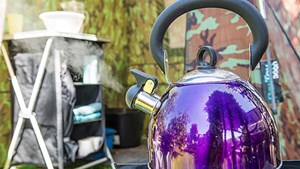 Many people enjoy camping at Certificated Sites, Club social camping meets or Temporary Holiday Sites and will be familiar with the term ‘own sanitation essential’ or ‘own san ess’, which means there is no toilet or shower block on site. But for those of us who generally enjoy full-facility campsites, it may be a little daunting to consider camping without an amenity block.
Many people enjoy camping at Certificated Sites, Club social camping meets or Temporary Holiday Sites and will be familiar with the term ‘own sanitation essential’ or ‘own san ess’, which means there is no toilet or shower block on site. But for those of us who generally enjoy full-facility campsites, it may be a little daunting to consider camping without an amenity block.
Watch our advice video here.
All campsites are required to provide fresh clean drinking water and waste disposal facilities and fortunately there are many ways to provide your own toilet and washing facilities at a campsite with discretion and hygiene. One simple way to recall the main things you may want to take with you if you do not have a washroom in your caravan, motorhome or trailer tent is to remember BATHS:

B is for basin
You will need something to hold your water at a decent height for washing. You can buy a camping washstand made for the purpose or, at the other end of the scale, build your own by lashing together some broomsticks, as you may have learnt with the Scouts or Guides. But for most people, a standard camping (or field) kitchen or a camping cupboard, plus a washing-up bowl and a jug of water, should do the trick.
You will find some examples of camping kitchens here:
A is for annexe
Most people like a little privacy for washing and if you have a large family tent there may be a side annexe you could use. If not, there are many utility tents on the market that can be pitched next to your unit.
 Think about how much space you need inside. If you are just looking for a toilet tent then a medium-height pop-up tent might suffice, but if you want to set up a complete en-suite washroom then you will need something with more height and floor space as seen here.
Think about how much space you need inside. If you are just looking for a toilet tent then a medium-height pop-up tent might suffice, but if you want to set up a complete en-suite washroom then you will need something with more height and floor space as seen here.
If you are likely to get water on the floor then you may not want to fit a groundsheet. A few plastic pathway tiles from a DIY store can protect the grass (and your feet) and a large flexible builder’s trug is a cost-effective way to create a shower tray or a fun bath for toddlers or infants.
Some examples of toilet tents that may be suitable are:
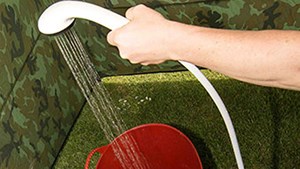 You will find some utility tents here:
You will find some utility tents here:
Top tips
- Bowls that can be stored inside each other are easier to transport
- The washroom area can be used for any holiday laundry or washing the dishes too.
T is for toilet
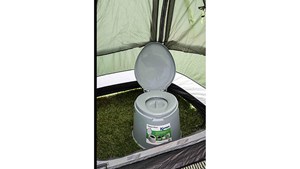 One essential part of your portable own-sanitation camping kit is the toilet. Many campers already take a loo for children or to avoid a midnight excursion to the toilet block even on full-facility campsites. At the basic end of the portable toilet range is the bucket-with-toilet-seat style unit.
One essential part of your portable own-sanitation camping kit is the toilet. Many campers already take a loo for children or to avoid a midnight excursion to the toilet block even on full-facility campsites. At the basic end of the portable toilet range is the bucket-with-toilet-seat style unit.
However, many will prefer a model that holds the waste in a separate container that is sealed most of the time. Thetford’s Porta Potti is probably the best known of this type. The lower section holds the waste and it can be easily transported to the Chemical Disposal Point (CDP) for emptying, similar to a cassette toilet from a caravan or motorhome.
You will also need appropriate chemicals to suit both the toilet and your campsite’s sewerage system. Take a look at our magazine feature online, and our video how to maintain your cassette toilet.
Here are a few different styles of camping toilet:
KhaziPopalooH is for hot water
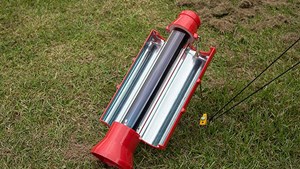 The easiest way to get hot water on the campsite is simply to boil a kettle or heat water in a pan on the stove. If you would like running water it is a little more challenging, but not impossible. You can buy systems with foot or 12V pumps that will take your water up from a tank. To get hot running water you will need to go a step further, with something to heat the water first.
The easiest way to get hot water on the campsite is simply to boil a kettle or heat water in a pan on the stove. If you would like running water it is a little more challenging, but not impossible. You can buy systems with foot or 12V pumps that will take your water up from a tank. To get hot running water you will need to go a step further, with something to heat the water first.
You may be able to add a water urn to a traditional wood burning stove to use heat from the stove pipe, if your campsite allows it.
An alternative for small quantities is a solar kettle, which uses mirrors to focus sunlight on a tube of water. It is not a speedy process, but on a sunny day it can give you boiling water without any extra fuel input.
If the running water option is for you, it is worth checking how you stop the water flow. A tap or showerhead that only lets water flow when you are pressing the switch can save water and reduce trips to the campsite tap.
S is for shower
Camping showers come in a surprisingly large number of types and styles. Some of the more basic ones are simply a water container with a shower attachment, often bearing a marked resemblance to a garden spray. You pump by hand to provide the pressure to push the water out of the showerhead.
Small electric showers generally use a 12V pump, powered by a car or leisure battery, to move water from a container to the showerhead. Again, you will need to warm the water somehow if you do not want a cold shower.
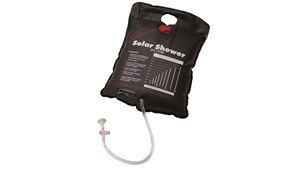 The more basic set-up is a solar shower. This consists of a black bag containing up to 20 litres of water connected to a showerhead with a piece of hose. The idea is to put the black bag in the sun to heat up the water during the day so it is ready for an evening shower. The minor disadvantage is temperature control – you’ll need to take the black bag out of the sun a short while before you plan to use the shower, to allow the water to cool slightly. With multiple bags everyone can set their own temperature. This is a cheap and cheerful solution and some utility tents come with hooks or racks to hold the water bag.
The more basic set-up is a solar shower. This consists of a black bag containing up to 20 litres of water connected to a showerhead with a piece of hose. The idea is to put the black bag in the sun to heat up the water during the day so it is ready for an evening shower. The minor disadvantage is temperature control – you’ll need to take the black bag out of the sun a short while before you plan to use the shower, to allow the water to cool slightly. With multiple bags everyone can set their own temperature. This is a cheap and cheerful solution and some utility tents come with hooks or racks to hold the water bag.
Did you know?
Many Club members can remember the time when the first thing you did when you arrived on a new campsite was to dig the trench for the latrine.
The Chemical Disposal Point (CDP) is often known as an Elsan point, after the London entrepreneur Ephraim Louis (EL) Jackson who marketed the first chemical toilet in the 1920s. The name comes from his initials and the word ‘sanitation’. The Elsan brand still supplies toilets and chemicals today.

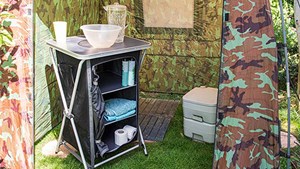 Outwell Drayton Kitchen Table
Outwell Drayton Kitchen Table